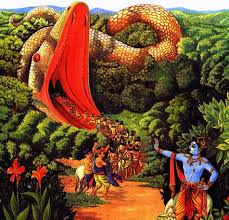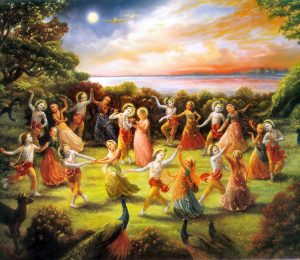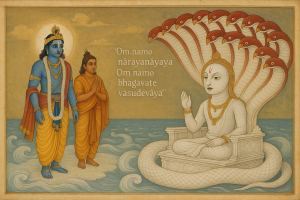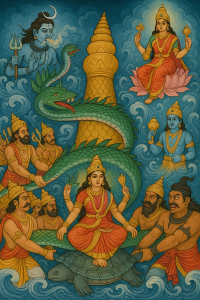The Bond of Friendship Deepens in Vṛndāvana
Every day in Vṛndāvana, Kṛṣṇa and His friends would take the calves and venture deep into the forests, playing on the riverbanks, climbing trees, mimicking birds, and enjoying the bounty of nature. The forests of Vraja were transformed into a celestial playground, sanctified by the touch of the Lord’s lotus feet.
The cowherd boys saw Kṛṣṇa not as God, but as their dearest friend—someone who laughed with them, played with them, and lovingly shared His food.
Kaṁsa Sends Aghāsura
Tormented by fear and rage, Kaṁsa, the demoniac king of Mathurā, had already sent many of his allies to kill Kṛṣṇa—Pūtanā, Tṛṇāvarta, Śakaṭāsura, Vatsāsura, and Bakāsura—all of whom had met their end. Now, desperate and frustrated, Kaṁsa turned to Aghāsura, another powerful demon and the eldest brother of Pūtanā and Bakāsura.
Burning with anger over the death of his siblings, Aghāsura resolved to avenge them by killing Kṛṣṇa and all His friends at once.
The Form of a Giant Serpent
Aghāsura took the form of a gigantic python, so large that his mouth stretched like a mountain cave, his tongue appeared like a vast red road, and his teeth were like daggered cliffs. His lower jaw touched the earth, and his upper jaw touched the sky. His body extended for miles, lying across the forest floor.
The demon positioned himself in the path of the cowherd boys, disguising his mouth as a shaded cave, inviting them to enter.
The Boys Enter the Serpent’s Mouth
The cowherd boys, innocent and trusting, saw what appeared to be a cool cave on a hot day. Thinking it a delightful place to rest, they laughed and exclaimed:
“Let’s go in, brothers! This cave looks like a new playground!”
Though some hesitated, they ultimately entered Aghāsura’s mouth, unaware of the danger. They were completely absorbed in their friendship and affection for Kṛṣṇa.
Kṛṣṇa Reveals His Protection
Kṛṣṇa, though knowing the truth, allowed the boys to enter. He wished to glorify their friendship and show how pure devotion is always protected, even in the face of death.
Then, Kṛṣṇa entered Aghāsura’s mouth Himself.
The demon rejoiced—“Now I have swallowed all of them!”
But he could not close his mouth. The Lord expanded His divine form within, blocking the demon’s throat, preventing him from breathing.
The Destruction of the Demon
Aghāsura tried to shut his mouth, but Kṛṣṇa had grown too large. Struggling in agony, his eyes rolled, his limbs froze, and his life air became choked. Finally, his soul burst out from the top of his head in the form of a brilliant flame.
At that moment, Kṛṣṇa returned to His small boyish form, brought all His friends back to consciousness, and walked out unharmed, as if from a picnic.
The Supreme Lord Grants Liberation
As soon as the soul of Aghāsura left the body, it hovered in the sky, waiting. When Kṛṣṇa emerged, it entered His divine form, attaining complete liberation (sāyujya-mukti). This was astonishing—even a demon who attempted to kill Kṛṣṇa attained perfection simply by coming in contact with the Lord.
The Demigods Rejoice
The celestial beings in heaven were filled with wonder. They rained down flowers, played heavenly drums, and offered praises:
“Who can understand the compassion of this Supreme Lord? Even His enemies attain liberation!”
The Gopas Continue Their Play
The cowherd boys, not understanding the full event, laughed and returned to their games. For them, Kṛṣṇa had simply brought them out of another cave. They were so immersed in sakhya-rasa, the friendship mood, that even death could not break their joy.
Lessons to Be Learned:
- Kṛṣṇa protects His devotees, even when they are unaware of danger.
- The Lord’s presence purifies, even a deadly demon.
- Pure friendship with the Lord (sakhya) is a relationship beyond logic—it is an exchange of heart and soul.
- The Lord’s compassion is inconceivable: even His enemies are uplifted.
- Devotional service is the safest shelter, more powerful than any fear.
Origin of the Story: Harivaṁśa Purāṇa – Viṣṇu-parva, Chapters 28–31



